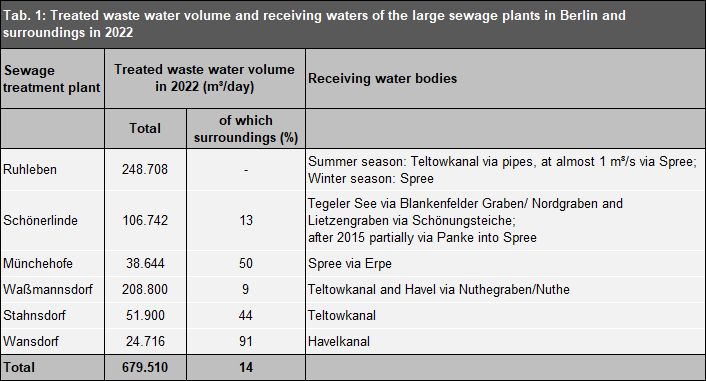Precipitation and waste water from private households, public institutions, industry and trade, as well as run-off from public road areas, generate large quantities of rain and waste water in Berlin. These need to be drained, and if necessary, treated. In 2022, some 680,000 m³ of waste water from private households, trade, industry and public institutions, as well as rainwater from Berlin and its surrounding areas was treated in the sewage plants per day. This volume corresponds to a rate of almost 8 m³/sec. It therefore represents about 15 % of the run-off of the Unterhavel river below Berlin at average water flow. The amount of waste water produced in Berlin could fill the Großer Wannsee lake in three weeks.
A sewerage network with a total length of 9,768 km, operated by the _Berliner Wasserbetriebe_ (BWB, Berlin Waterworks), is used for the disposal of waste water. It was constructed based on two different systems, the combined and the separate sewerage system, and consists of a total of 4,421 km of waste water drains, 1,927 km of combined water drains and 3,349 km of rainwater drains, as well as numerous other drains and structures, serving special purposes, such as rainwater overflows, retention basins and culverts. With the help of 166 pumping stations and a network of 1,194 km of pressurised sewage pipes, the collected waste water is pumped to the sewage plants.
The combined sewerage system was built from 1873 onwards to drain the entire urban area of Berlin as it was then. It was based on a design by James Hobrecht. However, towns and communities outside the historic city centre of Berlin and Spandau, which were independent until 1920, mainly built systems based on separate drainage. After their incorporation into Berlin, their facilities were combined into today’s two systems. Drainage areas are aligned with river courses and canals, and follow elevations. The boundaries of the drainage areas differ from those of the boroughs. About four fifths of Berlin’s areas connected to a sewerage system are drained by the separate system, and the remaining fifth by the combined system (SenStadt 2001).

